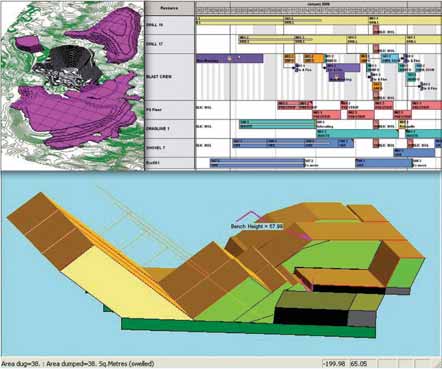
Miners Turn to Integrated Technology
To offset turnover and share data in a more timely fashion, mining companies are
looking at new software tools
By Steve Fiscor, Editor-in-Chief

Building a Sustainable Scheduling Network
Runge, a global mining consulting firm,
is one of the companies leading the way
in the area of integrated enterprise solutions
for mining. The company has developed
a mine management system called
Mining Dynamics, which transfers data
from Xact, the firm’s short-term planning
system, and integrates it with SAP using
a composite application. This allows Xact
to act as a composite application, integrating
with SAP’s Enterprise Resource
Planning system (ERP).
Mining Dynamics bridges the gap between the mine planner, operations manager and the production supervisor. The mine planner works with Xact and knows the importance of time, budgetary, and operational constraints. That person creates schedules and then recreates them with each operational change. Managers interact with the system using a Web browser. The operations manager determines whether the schedule meets his needs. He approves and rejects schedules based on his production goals. The production supervisor carries out the schedule. To do this, he needs to get production requests from SAP. The entire system allows mine personnel to concentrate on their jobs without getting bogged down in data entry.
In the background, Mining Dynamics works hard to make sure that the Web interface is kept up-to-date with changes from the short-term planners. Data is constantly moving and Xact is being integrated into the ERP. Using the power of workflow and data management, the system can be thought of as a completely auditable process, providing a high degree of automation.
Xact replaces the ad-hoc systems that are largely Excel spreadsheets (or some other homegrown database) that have been developed for daily, weekly, and rolling two- to three-month planning.
“Rather than Runge developing new software—and we had scheduling software— we took a user-based approach to find out why conventional scheduling software was not hitting the mark and what people would want,” said Pat Williams, general manager-strategic development, Runge. “What bubbled to the surface was that for short-term planning a lot of the mines are just trying to keep the operations going as best they can. For today, tomorrow, and the next shift, the planner only had a small amount of options at their disposal.”
The functionality of most computerbased scheduling systems is a craftsmen’s tool kit of features and options. That is great for scenario-based analysis and different life-of-mine or longer term strategies and options. In the short term, however, a mine often needs to deliver a certain tonnage to the plant while counterbalancing other issues such as a machine that’s down in one pit and water problems in another. The short-term planning tool now becomes an operations tool. The end-user needs something that gives them one interface, immediate response, and all of the tools in a drag drop with a mouse.
The selling point of Xact boils down to simplified workflow and making their jobs easier. “Scheduling is scheduling,” Williams said. “That’s really the different approach we have taken. It’s not about the science and technology so much as it’s about making the end-users’ life simple, intuitive and straight-forward.”
An operations engineer, a medium- to long-term planner, and an executive all view the operations differently and they usually focus on a different specific area. While a lot of popular software tools exist, one of the emerging needs is that the data generated from that tool fit into the mine’s enterprise system.
Xact, as a specialist technical tool, weaves its way through the operations managment and through the rest of enterprise in an organized and integrated way. That introduced the SAP relationship. SAP is a major software player providing a lot of enterprise-wide infrastructure for mining companies.
“SAP also has an acknowledged white space in their product footprint that relates to mining technology,” Williams said. “They do not want to get involved in that area because they realize that it requires industry know-how. They have partnered with groups such as Runge who can not only organize that back office suite of mining technology, but provide a gateway to their Enterprise Resource Planning system.”
Short-Term Planning
Xact has been available for a little more
than two years. The software is on its
fourth release and Runge has 55 or 60
licenses worldwide.
Xact is designed to run on a dual screen PC set-up, where on one side the user can see the mine being scheduled and the interface is more through the Gantt chart where the operating is dragging and dropping the scheduling blocks.
With less technical staff and an aging workforce, the mines want to build sustainability into management processes knowing there might be even less people in the next five to 10 years. “It’s not so much about the brilliance of the software’s technical achievement, it’s more about building a sustainable and robust process, where people who support the operation can come and go and the operation continues,” Williams said.
Xact is an engineering tool. The SAP product composite is the process of linking and integrating Xact with SAP. Xact is the tool the expert uses and the SAP product composite takes the data from Xact and shares it with the rest of the operation.
Rather than building all of the technologies themselves, SAP has embarked on the Industry Value Network (IVN), where specific, complementary technology partners have been invited to collaborate with SAP. The benefit is that the end-user still sees a complete area being addressed while SAP and its partners do the work behind the scenes to make sure that the integration works smoothly.
A New Theory of Business Integration
Runge has a large presence in mining and
they are seeking to open markets in emerging
worlds such as Russia and Brazil.

This new theory of business integration allows firms to focus on their strength. “We will keep doing what we know how to do and not spend time trying to branch into other areas,” Williams said. “That’s the underlying efficiency to the concept that SAP is promoting. They encourage people to be efficient with what they do and SAP can provide better tools for their customers.”
Important information exists in various places throughout an organization. “There seems to be a big push for one source of the truth,” Williams said. “In reality, however, individual pieces of information exist as single sources of the truth. We are able to integrate these sources to produce outcomes whether it’s a production plan or an action plan on when equipment will be maintained.”
As an example of how the system works, before a planning engineer updates the plans for the following day, the first thing he needs to know is what equipment is available. For a majority of SAP customers, that information exists in the maintenance system.
With the integration, the engineer can pull that information down, have it automatically updating Xact and the user automatically knows what’s available. Instead of calling the shop or visiting the pits, the data is already available.
The same logic applies to GPS systems on the equipment along with the mechanical availability. The planning engineer knows where the equipment is in real time and whether it’s available. Instantly updating the system, the planner can plan and re-plan in a matter of minutes.
Once they complete and publish the plan, that information goes back to SAP where production orders are issued and maintenance planners and operations people can determine their workloads.
“The thrust is the sustainable implementation of technology solutions,” Williams said. “It benefits a mine in several ways, most notably though they can actually own sustainable business processes. The tools themselves really become secondary.” In the future, mining organizations will need to be more responsive to meet increasing demands. Critical business systems, such as these, will provide the solution.